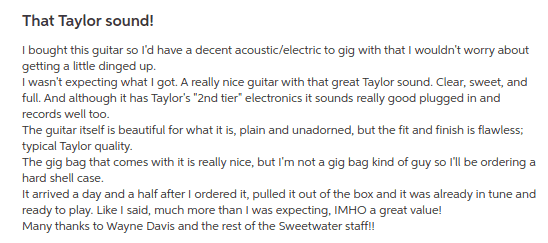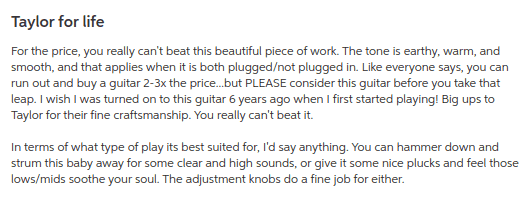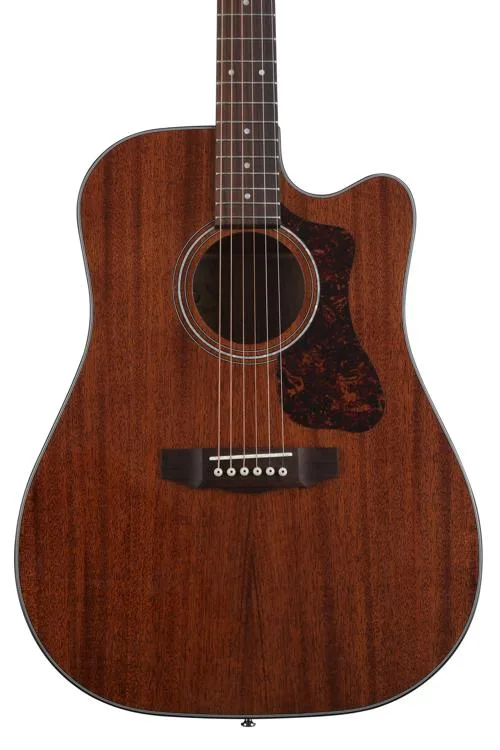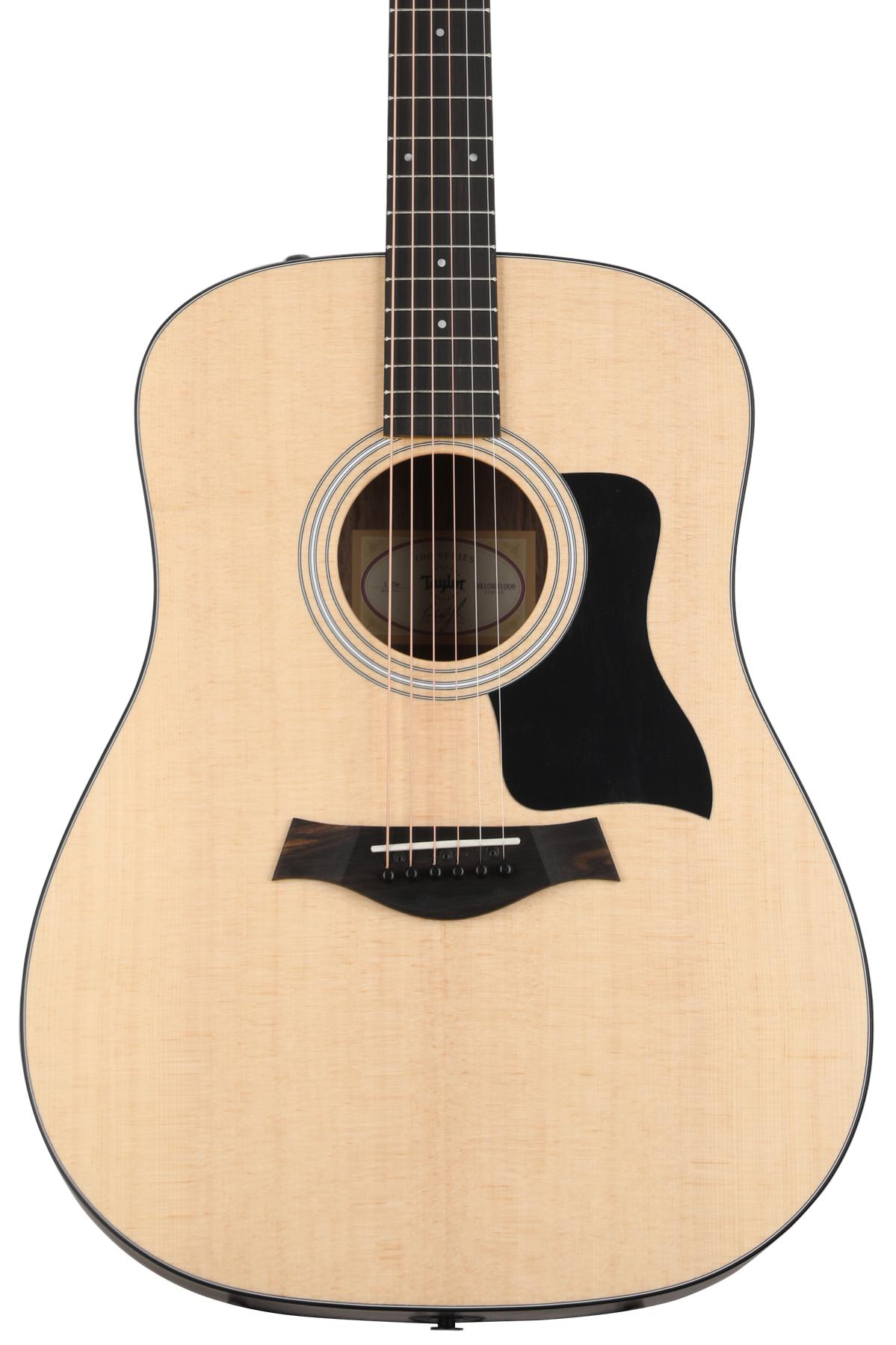If you're at all familiar with the world of acoustic guitars, the chances are good that you've heard of Taylor Guitars. This company started in the 1970s, is now one of the foremost manufacturers of quality acoustic guitars.
That said, Taylor guitars tend to be expensive, and if you're on a budget, it can be hard to find an affordable model. Luckily, the 110E is a Taylor guitar that's solidly midrange priced. Despite its relative affordability, this model has premium features and Taylor's innovative design.
Of course, before investing in a well-made guitar like a Taylor, it's wise to learn what you can about an individual guitar and its features. In this Taylor 110E guitar review, we'll delve into what sets this model apart.
Mid-Range Guitar
When you buy a guitar that's better quality than a beginner model, you're investing. And while it might be acceptable to buy the first beginner guitar model you see when you're first starting, doing some research before purchasing a mid-range guitar is a good idea.
Since the goal is to end up with a guitar, you'll be playing for years to come, and you'll want to make sure the guitar you pick is suited to the music you play. If you plan on playing live, you might want to consider an acoustic-electric. (You can, of course, add a pick up later on, but that's an expense and a hassle.)
Similarly, consider the guitar's construction. An acoustic with a spruce top will have a bright, balanced sound, whereas something with a cedar top will have a darker, mellower sound perfect for fingerstyle playing. And if you want to verify that you've made the right choice before you buy, reading reviews and listening to demos is also helpful.
Features and Benefits
Reviews and sound demonstrations offer useful information as you shop for a new guitar, but it's also essential to look into its features and benefits on your own. Here's what you need to know about the 110E before deciding whether or not to purchase it.
Tonewoods And Sound Quality
When it comes to tonewoods, the Taylor 110E has the classic top of many acoustics: solid Sitka spruce. Spruce produces a bright sound with generous sustain. However, its back and sides are a little different--they're made of walnut. Like many mid-range guitars, this one has a back and sides that aren't solid.
But while many cheaper manufacturers use laminates made of plywood pressed between layers of hardwood, Taylor's laminate is made by pressing together layers of hardwood. While this won't result in quite the same sound as solid wood, it's much better than plywood laminates.
As a tonewood, walnut has a dense character that only improves with age. It mainly emphasizes mid-range tones, making it the perfect companion for a spruce top. Plus, walnut has a beautiful grain that isn't often seen on acoustics.
If you're interested in hearing how the Taylor 110 sounds, check out this video to listen to it in action.
Build And Body Style
This guitar is a dreadnought, which is the most common acoustic guitar body style. This body type is the most common because it's the most versatile--it has plenty of low ends and offers a rich sonic profile that's good for playing solo, accompanying voice, or in a band.
As for bracing, this guitar has X bracing. X bracing is incredibly strong without getting in the way of sound. Taylor also includes scalloped bracing, which helps evenly reflect tone for powerful projection and a rich sustain.
Lastly, like all Taylor guitars, the 110E features Taylor's unique and patented neck shape. If you've ever played a Taylor, you can tell the difference instantly. The slim neck makes it easier to barre chords, even with small hands. And its slim profile is incredibly fast, letting you move up and down the neck with ease.
Other Features
The 110E has several features that aren't often seen at guitars at this price range. To start, it has a Tusq nut. This composite material is designed to mimic the tonal properties of ivory. If you've ever upgraded a guitar to a Tusq nut, you know that it instantly improves sustain. Plus, it can help enhance tuning stability.
The 110E's saddle is made of micartite, which is a composite designed as a substitute for bone. It's often found on higher-end guitars, and it can improve sound quality and sustain. Its chrome tuners are made in-house, and they help keep your instrument in tune, even after playing for an extended period.
Electronics
While Taylor is known for its innovation in design, that innovation extends to electronics design as well. This guitar comes equipped with Taylor's Expression System 2. This design is an improvement on the traditional under-saddle piezo pickup.
While under-saddle pickups are often standard, they don't pick up the full range of your guitar's sound. However, by placing the pickup behind the saddle, more of the guitar's tone is amplified. The arrangement results in fuller, more natural amplification when playing live gigs.
While this system isn't Taylor's premier pickup system, its design means it delivers amplification that's superior to many other models. It also features an onboard preamp which helps you dial in just the right tone for any performance.
Finish
When buying an instrument, finish usually doesn't matter as much as other features. But if you're like most guitarists, you do care about how your guitar looks to some extent. And if you prefer the classic look of a natural-finish acoustic guitar, you'll probably love the finish on the 110E.
Taylor has a gloss finish that emphasizes the natural grain of its Sitka top. And with a black pickguard and ebony fretboard, it has the simple elegance of most classic dreadnoughts.
Social Proof of the Guitar
Before buying any instrument, it's wise to look to see what other buyers have said about it. Here, we've included three reviews from those who have chosen the 110E. Since many of these reviewers have experience playing this guitar and others, their input may prove useful when deciding whether you want to make the 110E your next guitar purchase.

The above Taylor 110E review praises this guitar's playability and quality. And as this reviewer points out, its electronics are excellent despite not being the top line that Taylor offers.

The above review is primarily useful, as it points out one of Taylor 110's strengths--its rich and versatile tone. As the review mentions, this guitar has features that are often found on guitars that cost two or three times the price.

This review is an especially useful one, as it addresses Taylor's strengths along with some of its shortcomings. However, it reaches the same conclusion that many reviewers have come to--that the Taylor is an excellent value for the price range.
Alternatives to Taylor 110E
Before you decide to purchase a 110E, it's a good idea to explore similar models from other manufacturers. Here, we've included three potential alternatives you may want to consider.
Martin Dreadnought Junior
How it Compares to Taylor 110E
Review
While it's been in the business longer than Taylor, Martin is renowned as one of the best manufacturers of acoustic guitars. The Dreadnought Junior is a smaller-sized guitar with unique features, making it suitable for gigging. It has a thinner body, which is more commonly seen on 000-body guitars. And with smoother edges, it's comfortable to play standing.
The Dreadnought Junior comes equipped with Fishman Sonitone electronics for precise, faithful sound reproduction when playing live. It has a solid Sitka spruce top, and its Sapele back and sides offer a balanced tone for an affordable price. Plus, it costs just about the same as the 110E. However, if you prefer the fuller sound of a traditional-sized dreadnought, you may not want a guitar with a smaller body.
If you want a smaller acoustic guitar that's optimized for playing live, be sure to give this unique model a look.
Guild D-120CE
How it Compares to Taylor 110E

Review
Like Taylor, Guild is a manufacturer known for its quality acoustic guitars. And this model, offered at almost the same price as the 110E, has unique specs suited for players who want to stand out.
To start, this guitar has an all-solid wood construction. But that wood is different from your typical acoustic--the D-120CE is made of African mahogany. This lightweight wood is known for thick, balanced tone, and it's especially suitable for performing with other instruments.
This guitar is modelled faithfully after 1960s Guild acoustics, making it an excellent choice for those who prefer vintage guitars. It also is equipped with electronics that are a collaboration between Guild and Fishman. If you're looking for something a little different, be sure to check this guitar out.
Gibson G-45 Studio
How it Compares to Taylor 110E

Review
Gibson is a true classic manufacturer of acoustic and electric guitars, and the G-45 Studio is a genuine Gibson without all the frills of more expensive models. While it's a bit more expensive than the 110E, it offers unique features perfect for playing for long periods.
Its slim, fast neck allows you to play for hours without fatigue, and it's walnut body and Sitka spruce top, like that of the 110E, blend darker and brighter tones to create a complex sonic profile. Grover tuners and a Tusq nut and saddle offer tuning stability to keep you playing longer. If you have a little more money to spend and want to consider a Gibson, give this beautiful guitar a look.
In Conclusion
While the price point makes it more expensive than some midrange guitars, the Taylor 110E is worth the extra expense if you can afford it. With quality electronics, a room-filling balanced sound, and an attractive finish, this is a gig-worthy guitar. However, it's just as well suited to recording or playing at home.
And while it may not have quite the dazzling tone of a higher-end Taylor, this guitar is a worthy choice for those who have dreamed of playing a Taylor acoustic. If you want to purchase one or just learn more about the 110E, click here to check it out.





